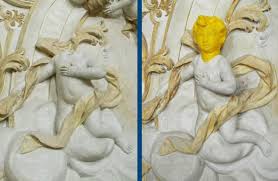
1 April 2016 – The next time some jackass puts his fist through a priceless painting to prove his libertarian cred, could a 3D printer save the day?
Chances are, it could. Part of the reason for this is that 3D printers and 3D scanners are in a position to capture the texture of canvas art, and recreate it almost perfectly, in a way that a simple printer on its own never could.
Note: I became involved in art restoration through a very close friend of my wife who is an art restorer at the Basilica di Santa Maria Maggiore in Rome. I have had the privilege of seeing the restoration laboratory of the Vatican Museums.
The concept got its start thanks to work by Fujifilm[footnote] on its technology called Reliefography. In 2013, the company created version of a number of Vincent Van Gogh’s paintings by using a high-quality 3D scanner to pick up the details of the art, including the exact texture of the paint on the canvas, then reprinting the art using a 3D printer. The quality of the final result, called a Relievo, is impressive, if not inexpensive — each replica costs $34,000, certainly not cheap enough to put in your bathroom, but definitely nice enough as a way to get a work of art into another museum.
The first replications went to Hong Kong, where they were put in a shopping mall rather than a gallery—a place you’d never want to put a Van Gogh otherwise.
“Considering current developments regarding the 3D printing process, the creation of a three-dimensional reproduction is an exciting but, most of all, logical new step,” Van Gogh Museum Director Axel Rüger said in a statement. “By means of Relievos, availability and accessibility of the works of art can be enhanced, which gives the Van Gogh Museum the opportunity to realize its mission to inspire and enrich as large an audience as possible.”
Not to be outdone, Canon’s Océ arm has also been working on similar technology, and last year the company teamed with the 3D Printing firm Arius Technology and the custom framer Larson-Juhl to launch a new service called Verus Art, which specializes in “re-creations,” rather than reproductions, of fine art. [note: the previous link is a very cool video]
The new initiative is already working to make art reproduction into a slightly more realistic endeavor for consumers, with pieces that cost between $1,000 and $8,000—a perfect price for your yuppie friends, if not for you. (Quick, someone tell Steve Wynn!)
And while museums might hold onto the originals, the Verus Art recreations create something tangible of their own: a revenue stream.
“The partnership has been successful in developing not only a truly unique product line, but has maintained a balance between economic and artistic interests,” Larson-Juhl CEO Drew Van Pelt explained. “The royalties will enable museums the opportunity to further invest in the acquisition, conservation and education programs on art and heritage, from which we all benefit.”
Maybe in the future, we’ll all be able to afford a Picasso—and not just a poster print of that kinda scandalous one with an easter egg only an artist coloring in the VHS cover of The Little Mermaid could love.
The rise of Verus Art and similar products makes one wonder if we’re going to eventually reach a point where we create backups of valuable physical things much in the same way we do valuable digital files.
That’s a weird thing to consider, of course, but clearly the technology is already here and is only going to get better over time. And that, of course, raises the possibility that high-quality replicas could hurt the value of the real thing, especially when the replica, to quote a U2 song, is even better than the real thing.
When you think about it, the things that make a genuine artifact valuable are its tangible factors — the things you would never be able to replicate in a copy. The problem is, we’re getting closer than ever to being able to replicate those things, and it could create seismic shifts in the way we interpret creativity.
As Sean Parker’s bank account will tell you, the moment when digital technology was able to replicate intangible objects with bits and bytes, was the moment when the rules of creativity were forever shifted, creating new winners and losers.
When valuable physical objects can be backed up to the nanometer, does the original object lose its value? Check back a couple of decades — or maybe sooner. Then we’ll know for sure.
1 Fujifilm is a client hence my knowledge of their technology.